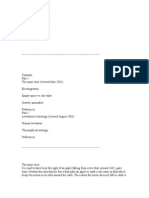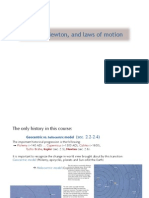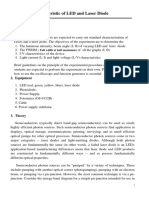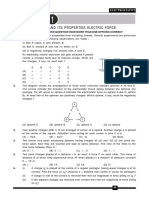2 Force and Mass: 2.1 Galileo's Principle (Newton's First Axiom)
2 Force and Mass: 2.1 Galileo's Principle (Newton's First Axiom)
Uploaded by
Ammir SantosaCopyright:
Available Formats
2 Force and Mass: 2.1 Galileo's Principle (Newton's First Axiom)
2 Force and Mass: 2.1 Galileo's Principle (Newton's First Axiom)
Uploaded by
Ammir SantosaOriginal Description:
Original Title
Copyright
Available Formats
Share this document
Did you find this document useful?
Is this content inappropriate?
Copyright:
Available Formats
2 Force and Mass: 2.1 Galileo's Principle (Newton's First Axiom)
2 Force and Mass: 2.1 Galileo's Principle (Newton's First Axiom)
Uploaded by
Ammir SantosaCopyright:
Available Formats
2 Force and Mass
2.1 Galileos Principle (Newtons First Axiom)
Galileos principle, which forms the starting point of theoretical mechanics, states that in an inertial frame of reference all bodies not acted upon by any force move rectilinearly and homogeneously at constant velocity v . The main diculty arising here lies in the realization of an inertial frame, which is only possible by iteration: to a zeroth degree of approximation an inertial frame is a system of Cartesian coordinates, which is rigidly rotating with the surface of the earth, to which its axes are attached; to the next approximation they are attached to the center of the earth; in the following approximation they are attached to the center of the sun, to a third approximation to the center of our galaxy, and so on. According to Mach an inertial frame can thus only be dened by the overall distribution of the stars. The nal diculties were only resolved later by Einstein, who proposed that inertial frames can only be dened locally , since gravitation and acceleration are equivalent quantities (see Chap. 14). Galileos principle is essentially equivalent to Newtons First Axiom (or Newtons First Law of Motion).
2.2 Newtons Second Axiom: Inertia; Newtons Equation of Motion
This axiom constitutes an essential widening and accentuation of Galileos principle through the introduction of the notions of force, F , and inertial mass, mt m. (This is the inertial aspect of the central notion of mass, m.) Newtons second law was originally stated in terms of momentum. The rate of change of momentum of a body is proportional to the force acting on the body and is in the same direction. where the momentum of a body of inertial mass mt is quantied by the vector p := mt v .1 Thus F =
1
dp . dt
(2.1)
Here we consider only bodies with innitesimal volume: so-called point masses.
2 Force and Mass
The notion of mass also has a gravitational aspect, ms (see below), where mt = ms ( m). However, primarily a body possesses inertial mass mt , which is a quantitative measure of its inertia or resistance to being moved2 . (Note: In the above form, (2.1) also holds in the special theory of relativity, see Sect. 15 below, according to which the momentum is given by p= m0 v 1
v2 c2
m0 is the rest mass, which only agrees with mt in the Newtonian approximation v 2 c2 , where c is the velocity of light in vacuo.) Equation (2.1) can be considered to be essentially a denition of force involving (inertial) mass and velocity, or equivalently a denition of mass in terms of force (see below). As already mentioned, a body with (inertial) mass also produces a gravitational force proportional to its gravitational mass ms . Astonishingly, in the conventional units, i.e., apart from a universal constant, one has the well-known identity ms mt , which becomes still more astonishing, if one simply changes the name and thinks of ms as a gravitational charge instead of gravitational mass. This remarkable identity, to which we shall return later, provided Einstein with strong motivation for developing his general theory of relativity.
2.3 Basic and Derived Quantities; Gravitational Force
The basic quantities underlying all physical measurements of motion are time : dened from multiples of the period of a so-called atomic clock , and distance : measurements of which are nowadays performed using radar signals.
The conventional units of time (e.g., second, hour, year) and length (e.g., kilometre, mile, etc.) are arbitrary. They have been introduced historically, often from astronomical observations, and can easily be transformed from one to the other. In this context, the so-called archive metre (in French: m` etre des archives ) was adopted historically as the universal prototype for a standard length or distance: 1 metre (1 m). Similarly, the archive kilogram or international prototype kilogram in Paris is the universal standard for the unit of mass : 1 kilogram (1 kg).
2
in German: inertial mass = tr age Masse as opposed to gravitational mass = schwere Masse ms . The fact that in principle one should distinguish between the two quantities was already noted by the German physicist H. Hertz in 1884; see [4].
2.3 Basic and Derived Quantities; Gravitational Force
However, the problem as to whether the archive kilogram should be used as a denition of (inertial) mass or a denition of force produced a dilemma. In the nineteen-fties the kilopond (kp) (or kilogram-force (kgf)) was adopted as a standard quantity in many countries. This quantity is dened as the gravitational force acting on a 1 kg mass in standard earth gravity (in Paris where the archive kilogram was deposited). At that time the quantity force was considered to be a basic quantity, while mass was (only) a derived one. More recently, even the above countries have reverted to using length, time, and (inertial) mass as base quantities and force as a derived quantity. In this book we shall generally use the international system (SI) of units, which has 7 dimensionally independent base units: metre, kilogram, second, ampere, kelvin, mole and candela. All other physical units can be derived from these base units. What can be learnt from this? Whether a quantity is basic or (only) derived , is a matter of convention. Even the number of base quantities is not xed; e.g., some physicists use the cgs system, which has three base quantities, length in centimetres (cm), time in seconds (s) and (inertial) mass in grams (g), or multiples thereof; or the mksA system, which has four base quantities, corresponding to the standard units: metre (m), kilogram (kg), second (s) and ampere (A) (which only comes into play in electrodynamics). Finally one may adopt a system with only one basic quantity, as preferred by high-energy physicists, who like to express everything in terms of a fundamental unit of energy, the electron-volt eV: e.g., lengths are expressed in units of c/(eV), where is Plancks constant divided by 2 , which is a universal quantity with the physical dimension action = energy time, while c is the velocity of light in vacuo ; masses are expressed in units of eV/c2 , which is the rest mass corresponding to the energy 1 eV. (Powers of and c are usually replaced by unity3 ). As a consequence, writing Newtons equation of motion in the form ma=F
2
(2.2)
r (relating acceleration a := d dt2 and force F ), it follows that one can equally well say that in this equation the force (e.g., calibrated by a certain spring) is the basic quantity, as opposed to the dierent viewpoint that the mass is basic with the force being a derived quantity , which is derived by the above equation. (This arbitariness or dichotomy of viewpoints reminds us of the question: Which came rst, the chicken or the egg?!). In a more modern didactical framework based on current densities one could, for example, write p the left-hand side of (2.2) as the time-derivative of the momentum, d dt F , thereby using the force as a secondary quantity. However, as already
3
One should avoid using the semantically dierent formulation set to 1 for the quantities with non-vanishing physical dimension such as c(= 2.998 108 m/s), etc.
2 Force and Mass
mentioned, a dierent viewpoint is also possible, and it is better to keep an open mind on these matters than to x our ideas unnecessarily. Finally, the problem of planetary motion dating back to the time of Newton where one must in principle distinguish between the inertial mass mt entering (2.2) and a gravitational mass ms , which is numerically identical to mt (apart from a universal constant, which is usually replaced by unity), is far from being trivial; ms is dened by the gravitational law: F (r ) = M s ms r R , |r R|2 |r R|
where r and ms refer to the planet, and R and Ms to the central star (sun), while is the gravitational constant. Here the [gravitational] masses play the role of gravitational charges, similar to the case of Coulombs law in electromagnetism. In particular, as in Coulombs law, the proportionality of the gravitational force to Ms and ms can be considered as representing an active and a passive aspect of gravitation.4 The fact that inertial and gravitational mass are indeed equal was rst proved experimentally by E otv os (Budapest, 1911 [6]); thus we may write ms = mt m.
2.4 Newtons Third Axiom (Action and Reaction . . . )
Newtons third axiom states that action and reaction are equal in magnitude and opposite in direction.5 This implies inter alia that the active and passive gravitational masses are equal (see the end of the preceding section), i.e., on the one hand, a body with an (active) gravitational charge Ms generates a gravitational eld G(r ) = Ms rR , |r R|2 |r R|
in which, on the other hand, a dierent body with a (passive) gravitational charge ms is acted upon by a force, i.e., F = ms G(r). The relations are analogous to the electrical case (Coulombs law). The equality of active and passive gravitational charge is again not self-evident, but in the considered context it is implied that no torque arises (see also Sect. 5.2). Newton also recognized the general importance of his third axiom, e.g., with regard to the application of tensile stresses or compression forces between two bodies. Three additional consequences of this and the preceding sections will now be discussed.
4
If one only considers the relative motion, active and passive aspects cannot be distinguished. In some countries this is described by the abbreviation in Latin actio=reactio.
2.4 Newtons Third Axiom (Action and Reaction . . . )
a) As a consequence of equating the inertial and gravitational masses in Newtons equation F (r ) = ms G(r) it follows that all bodies fall equally fast (if only gravitational forces are considered), i.e.: a(t) = G(r (t)). This corresponds to Galileos experiment6 , or rather thought experiment, of dropping dierent masses simultanously from the top of the Leaning Tower of Pisa. b) The principle of superposition applies with respect to gravitational forces: G(r ) =
k
(Ms )k r Rk . 2 |r Rk | |r Rk |
Here (Ms )k := k Vk is the mass of a small volume element Vk , and k is the mass density. An analogous superposition principle also applies for electrostatic forces, but, e.g., not to nuclear forces. For the principle of superposition to apply, the equations of motion must be linear. c) Gravitational (and Coulomb) forces act in the direction of the line joining the point masses i and k . This implies a dierent emphasis on the meaning of Newtons third axiom. In its weak form, the postulate means that F i,k = F k,i ; in an intensied or strong form it means that F i,k = (r i r k ) f (ri,k ), where f (rik ) is a scalar function of the distance ri,k := |ri r k |. As we will see below, the above intensication yields a sucient condition that Newtons third axiom not only implies F i,k = F k,i , but also Di,k = Dk,i , where D i,k is the torque acting on a particle at r i by a particle at rk .
In essence, the early statement of Galileo already contained the basis not only of otv os experiment, [6] (see also [4]), the later equation ms = mt , but also of the E and of Einsteins equivalence principle (see below).
You might also like
- Gravity and Antigravity (R)Document33 pagesGravity and Antigravity (R)aganju999No ratings yet
- Principle of Statics: Statics of Rigid Bodies Engr. Brenz Eduard C. IlaganDocument13 pagesPrinciple of Statics: Statics of Rigid Bodies Engr. Brenz Eduard C. IlaganGold MusicNo ratings yet
- The Theory of Relativity: And Other EssaysFrom EverandThe Theory of Relativity: And Other EssaysRating: 4.5 out of 5 stars4.5/5 (11)
- Module-1 - BASIC PRINCIPLES-Introduction To Statics - Print Version PDFDocument12 pagesModule-1 - BASIC PRINCIPLES-Introduction To Statics - Print Version PDFSyh TfkNo ratings yet
- Newton Laws of Motion PDFDocument5 pagesNewton Laws of Motion PDFTaylor Andres AmayaNo ratings yet
- Enhanced Article Session3Document6 pagesEnhanced Article Session3chinnavenkateswarluNo ratings yet
- Engineering Mechanics / Unit 1/ Module 1 Introduction of MechanicsDocument4 pagesEngineering Mechanics / Unit 1/ Module 1 Introduction of MechanicsMangam RajkumarNo ratings yet
- 1 Newtonian MechanicsDocument20 pages1 Newtonian MechanicsKevin Gonzalez100% (1)
- Ch1-Birth of Modern PhysicsDocument17 pagesCh1-Birth of Modern PhysicsMartín FigueroaNo ratings yet
- Introduction To Engineering MechanicsDocument24 pagesIntroduction To Engineering MechanicsghanshyamdassNo ratings yet
- Physics Lab Report 6: ForcesDocument14 pagesPhysics Lab Report 6: ForcesJustin PedrozaNo ratings yet
- Module 1 - Fundamental Concepts in MechanicsDocument9 pagesModule 1 - Fundamental Concepts in MechanicsErika Mae SanchezNo ratings yet
- 01 Mech - Introduction To Engineering MechanicsDocument13 pages01 Mech - Introduction To Engineering MechanicsCamille JarlosNo ratings yet
- Trusses 72 85Document91 pagesTrusses 72 85Carlorel AnteNo ratings yet
- Module 1 - Fundamental Concepts in Mechanics PDFDocument9 pagesModule 1 - Fundamental Concepts in Mechanics PDFRome Erwin Manalo FestinNo ratings yet
- Statics of Rigid BodiesDocument91 pagesStatics of Rigid Bodies20-08702No ratings yet
- Ga GR RevDocument74 pagesGa GR RevIrina AnanieNo ratings yet
- Space DynamicsDocument37 pagesSpace Dynamicspurushottam Kashyap100% (1)
- Modanese - Zero-Point Field Induced Mass vs. QED Mass RenormalizationDocument4 pagesModanese - Zero-Point Field Induced Mass vs. QED Mass RenormalizationFatima FróisNo ratings yet
- Engg1013 CH 01 Fundamental Concepts Part 12Document13 pagesEngg1013 CH 01 Fundamental Concepts Part 12Edrian Sergs G. BALLEZANo ratings yet
- Equilibrium Statistical MechanicsDocument56 pagesEquilibrium Statistical Mechanicsfevv1610No ratings yet
- Forces, Newton's LawsDocument5 pagesForces, Newton's LawsDoctora NourhanNo ratings yet
- Quantum Gravity For DummiesDocument7 pagesQuantum Gravity For DummiesDr Abhas MitraNo ratings yet
- Space Flight MechanicsDocument35 pagesSpace Flight MechanicsBorisBenedikterNo ratings yet
- Mystery of The Cosmological ConstantDocument15 pagesMystery of The Cosmological ConstantMajo BuroNo ratings yet
- Gravity and AntigravityDocument29 pagesGravity and AntigravityHaris Liviu100% (1)
- PinheiroBuker EPL PDFDocument6 pagesPinheiroBuker EPL PDFMario J. PinheiroNo ratings yet
- Basic ConceptsDocument12 pagesBasic ConceptsRaymondSanchezNo ratings yet
- Forces - and Newton's Laws of MotionDocument5 pagesForces - and Newton's Laws of MotionPatrick SibandaNo ratings yet
- Lecture Notes - Linear Elasticity TheoryDocument43 pagesLecture Notes - Linear Elasticity Theoryzcapg17No ratings yet
- Notes On Mechanical Vibrations: 1 Masses and Springs-The Linear OscillatorDocument10 pagesNotes On Mechanical Vibrations: 1 Masses and Springs-The Linear Oscillatoramlandas08No ratings yet
- Mayeul Arminjon - Gravitation As A Pressure Force: A Scalar Ether TheoryDocument10 pagesMayeul Arminjon - Gravitation As A Pressure Force: A Scalar Ether TheoryOppekeeNo ratings yet
- Tomil PDFDocument10 pagesTomil PDFMspamNo ratings yet
- 1 Classical MechanicsDocument11 pages1 Classical MechanicsJayant MukherjeeNo ratings yet
- PH 103 Fall 2008:, Fifth WeekDocument9 pagesPH 103 Fall 2008:, Fifth WeekAli AhmadNo ratings yet
- Quantum Field TheoryDocument16 pagesQuantum Field Theoryrr1819100% (1)
- Mass - WikipediaDocument129 pagesMass - WikipediaOzhenNo ratings yet
- Gravity and AntigravityDocument31 pagesGravity and Antigravitymarinboy55No ratings yet
- Sources of GravityDocument4 pagesSources of GravitySekar ChandruNo ratings yet
- Motion: Immobile, Stationary, or To Have A Constant or TimeDocument9 pagesMotion: Immobile, Stationary, or To Have A Constant or TimeJohn HenryNo ratings yet
- Laws of PhysicsDocument7 pagesLaws of PhysicsRinta MoonNo ratings yet
- 'time') ' Hence The Term "Mass-Energy Equivalence"Document22 pages'time') ' Hence The Term "Mass-Energy Equivalence"Cristhianares Lonjawon OboLightNo ratings yet
- Gravity and Anti-GravityDocument31 pagesGravity and Anti-GravitySergio Fiuza FiuzaNo ratings yet
- Classical Mechanics - WikipediaDocument40 pagesClassical Mechanics - WikipediaAyushNo ratings yet
- Emc 2Document6 pagesEmc 2Nishan SunarNo ratings yet
- Session OutcomesDocument28 pagesSession OutcomesrajeswariNo ratings yet
- Classical Mechanics Notes (1 of 10)Document13 pagesClassical Mechanics Notes (1 of 10)OmegaUserNo ratings yet
- What Quantum Mechanics Emerged FromDocument7 pagesWhat Quantum Mechanics Emerged FromAaron ChiuNo ratings yet
- 2 DynamicsDocument73 pages2 DynamicsEdwin HuangNo ratings yet
- Formula FizikDocument10 pagesFormula Fiziknew_farhanNo ratings yet
- Kepler, Newton, and Laws of MotionDocument15 pagesKepler, Newton, and Laws of MotionwonrfalfaNo ratings yet
- Electromagnetism MIT 8.022Document231 pagesElectromagnetism MIT 8.022RossoVerdi100% (2)
- Lecture 5 Kinetics-1Document54 pagesLecture 5 Kinetics-1farazbaloch7111No ratings yet
- Lectures On General RelativityDocument63 pagesLectures On General RelativityMichael Anthony MendozaNo ratings yet
- Gravito-Inert Mass: F R R A M RDocument4 pagesGravito-Inert Mass: F R R A M RLeon BlažinovićNo ratings yet
- Physics Cheat Sheet: Newton's Laws of MotionDocument2 pagesPhysics Cheat Sheet: Newton's Laws of MotionDonnie PeaseNo ratings yet
- Mass and GravityDocument27 pagesMass and Gravity2E19BrendanNo ratings yet
- On The Stability of Our UniverseDocument10 pagesOn The Stability of Our UniverseahsbonNo ratings yet
- Emc 2Document7 pagesEmc 2avanomminerNo ratings yet
- Kinetics - Force & Acceleration Part 1Document25 pagesKinetics - Force & Acceleration Part 1Jihan GorayahNo ratings yet
- Lecture Notes For General Physics 219Document158 pagesLecture Notes For General Physics 219Oliver356No ratings yet
- Doppler EffectDocument11 pagesDoppler EffectJoyceTangNo ratings yet
- Light Emitting DiodesDocument28 pagesLight Emitting DiodesAakash KulkarniNo ratings yet
- CBSE X Class Term - 1 Physics Practice Work Sheet 1Document10 pagesCBSE X Class Term - 1 Physics Practice Work Sheet 1chaitanya kambleNo ratings yet
- Architectural Acoustics: 5 Semester B. Arch DegreeDocument26 pagesArchitectural Acoustics: 5 Semester B. Arch DegreeSneha B SNo ratings yet
- Praktikum Bab Karakteristik LED Dan Laser DiodeDocument4 pagesPraktikum Bab Karakteristik LED Dan Laser DiodeErvina IkkeNo ratings yet
- Radiation of Heat From Human BodyDocument15 pagesRadiation of Heat From Human BodyrocguedesNo ratings yet
- Qs Based On Photoelectric EffectDocument5 pagesQs Based On Photoelectric EffectsdrgrNo ratings yet
- Color Light TextureDocument87 pagesColor Light TextureKeecy MoralesNo ratings yet
- Electrostat PDFDocument67 pagesElectrostat PDFdharunNo ratings yet
- Use of Fiber Optical Technology For Dam Filter Flow Monitoring of One Earthen DamDocument10 pagesUse of Fiber Optical Technology For Dam Filter Flow Monitoring of One Earthen DamMarcelo ProtzNo ratings yet
- Instruction Manual: DS-2000 Series Reflecting and Refracting TelescopesDocument44 pagesInstruction Manual: DS-2000 Series Reflecting and Refracting TelescopesBrandon BohannonNo ratings yet
- Basic Instrumentation: Joachim MuellerDocument45 pagesBasic Instrumentation: Joachim MuellerrahatilyasNo ratings yet
- Specifications of Hikvision DS-2CE56D0T-IRP Dome CameraDocument1 pageSpecifications of Hikvision DS-2CE56D0T-IRP Dome CamerasecurekartNo ratings yet
- Features: Philips BV Pulsera C-ArmDocument2 pagesFeatures: Philips BV Pulsera C-ArmMuhammad SohailNo ratings yet
- Detailed Lesson PlanDocument5 pagesDetailed Lesson PlanNikki Angelie TerrenalNo ratings yet
- Resonance in Open Air ColumnsDocument4 pagesResonance in Open Air ColumnsJobin IdicullaNo ratings yet
- Spec FiberCordsDocument3 pagesSpec FiberCordsBudi YantoNo ratings yet
- Optical Fiber Loose Tube Cable: (Fundamental Structures)Document4 pagesOptical Fiber Loose Tube Cable: (Fundamental Structures)Must PyurNo ratings yet
- Curved Mirror Image FormationDocument13 pagesCurved Mirror Image FormationBereket HaileNo ratings yet
- Basic Perspective Drawing (Cap 8)Document19 pagesBasic Perspective Drawing (Cap 8)Roxana TissieresNo ratings yet
- He-Ne LaserDocument171 pagesHe-Ne LaserVicky SekhriNo ratings yet
- The Optics Problem Solver, Fogiel - REA PublishersDocument832 pagesThe Optics Problem Solver, Fogiel - REA Publishersdelfino24127050% (6)
- Introduction To Lighting: Light and MaterialDocument2 pagesIntroduction To Lighting: Light and Materialzobia waheedNo ratings yet
- Light-Human Eye and The Colourful WorldDocument23 pagesLight-Human Eye and The Colourful WorldAbhinandan Borad95% (22)
- X-Ray Diffraction Analysis Principle InsDocument57 pagesX-Ray Diffraction Analysis Principle InsPrem Kumar100% (1)
- Science 8Document20 pagesScience 8Gelai javilloNo ratings yet
- Physics Syllabus ZimsecDocument57 pagesPhysics Syllabus ZimsecDigCity Club100% (1)
- Deped Physical Fitness Test V.Mapa High School Ii-Ss2 Mrs. MantoDocument4 pagesDeped Physical Fitness Test V.Mapa High School Ii-Ss2 Mrs. Mantoalfonse_sarmiento3194No ratings yet
- Chapter 8 PPT - Maxwell.importantDocument15 pagesChapter 8 PPT - Maxwell.importantOsama Hassan100% (1)

























































































